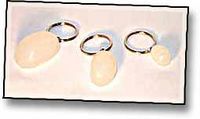Neuticle
Jump to navigation
Jump to search
Neuticles are a well known brand of testicular prosthesis manufactured by the CTI Corporation (of which they are a registered trademark) and used widely in the veterinary industry, available in a variety of sizes to suit different types of animals. In an attempt to be as "natural" as possible these silicone blobs have roughly the consistency of a gummi bear (although the older polypropylene "Neuticle Originals" are much harder). They are intended to replace testicles after castration.
Neuticles were first released in late 1995, and in 1998 they released their softer "Neuticle Naturals" line — since then about a hundred thousand have been sold for use in animals and for decorative purposes such as on key chains and necklaces. In addition, a small number of humans have had them implanted, both by underground cutters and legitimate doctors.
The first well-documented case of a human having a Neuticle implanted was Jim Webb (they are FDA approved), a 44 year old man from California who had his missing testicle replaced with one in 1999 (silicone implants had been banned in the US for human use since 1982).
